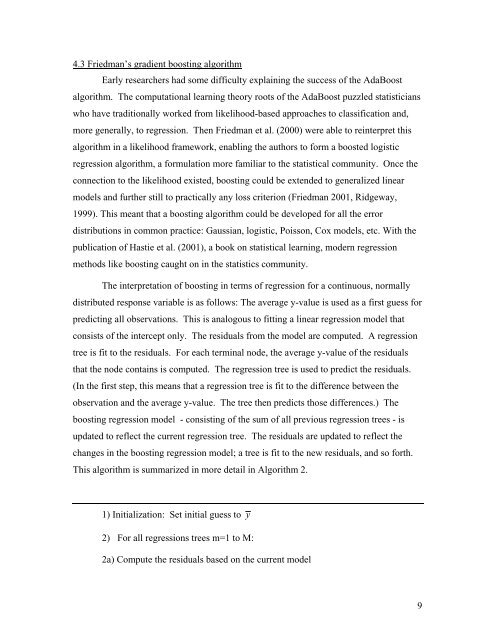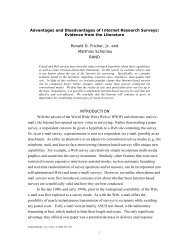Boosted Regression (Boosting): An introductory tutorial and a Stata ...
Boosted Regression (Boosting): An introductory tutorial and a Stata ...
Boosted Regression (Boosting): An introductory tutorial and a Stata ...
You also want an ePaper? Increase the reach of your titles
YUMPU automatically turns print PDFs into web optimized ePapers that Google loves.
4.3 Friedman’s gradient boosting algorithmEarly researchers had some difficulty explaining the success of the AdaBoostalgorithm. The computational learning theory roots of the AdaBoost puzzled statisticianswho have traditionally worked from likelihood-based approaches to classification <strong>and</strong>,more generally, to regression. Then Friedman et al. (2000) were able to reinterpret thisalgorithm in a likelihood framework, enabling the authors to form a boosted logisticregression algorithm, a formulation more familiar to the statistical community. Once theconnection to the likelihood existed, boosting could be extended to generalized linearmodels <strong>and</strong> further still to practically any loss criterion (Friedman 2001, Ridgeway,1999). This meant that a boosting algorithm could be developed for all the errordistributions in common practice: Gaussian, logistic, Poisson, Cox models, etc. With thepublication of Hastie et al. (2001), a book on statistical learning, modern regressionmethods like boosting caught on in the statistics community.The interpretation of boosting in terms of regression for a continuous, normallydistributed response variable is as follows: The average y-value is used as a first guess forpredicting all observations. This is analogous to fitting a linear regression model thatconsists of the intercept only. The residuals from the model are computed. A regressiontree is fit to the residuals. For each terminal node, the average y-value of the residualsthat the node contains is computed. The regression tree is used to predict the residuals.(In the first step, this means that a regression tree is fit to the difference between theobservation <strong>and</strong> the average y-value. The tree then predicts those differences.) Theboosting regression model - consisting of the sum of all previous regression trees - isupdated to reflect the current regression tree. The residuals are updated to reflect thechanges in the boosting regression model; a tree is fit to the new residuals, <strong>and</strong> so forth.This algorithm is summarized in more detail in Algorithm 2.1) Initialization: Set initial guess to y2) For all regressions trees m=1 to M:2a) Compute the residuals based on the current model9



